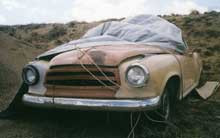Queen Isabella I is best known for bankrolling Christopher Columbus in his quest to the New World. Less remembered is her role, with husband Ferdinand (Ferdinand II of Aragon, Ferdinand V of Castile – he wore two crowns), in instigating the Spanish Inquisition. Which one, we might wonder, was on Carl Borgward’s mind when he introduced the Borgward Isabella in 1954?
Carl Friedrich Wilhelm Borgward was a manufacturer of small three-wheeled delivery vehicles he called “Goliath.” In 1929, he bought Hansa-Lloyd-Werke, another automaker, and merged it into a new Borgward Group, building Hansa cars and Lloyd and Goliath trucks. During World War II its output was military vehicles.
Postwar production didn’t resume until 1949, Borgward apparently having been interned and his factories destroyed. The first car was a slab-sided 1.5-liter sedan called the Borgward Hansa. In 1950, he introduced two small two-stroke front-wheel drive cars, the tiny 293 cc Lloyd and a 668 cc. Goliath. The Isabella, a unitary version of the Hansa with four-wheel independent suspension, debuted in June 1954. It came as a sedan, both with and without a canvas sunroof, a “Combi” station wagon, and a smart little cabriolet by coachbuilder Deutsch of Cologne. A coupe version was added in 1957. Power came from a 1493 cc. overhead valve four, developing 60 horsepower. A “TS” engine, which made 75 horsepower by increased compression, larger valves and a two-barrel carburetor, was available.
I discovered this Isabella coupe in Estes Park, Colorado, Gateway to the Rockies, while on a research trip. My main mission was study of the Stanley Steamer at the knee of Frank Hix, who instructed me in the art of firing up and raising steam. After successful liftoff, we took his Stanley 726 roadster to the Estes Park fairgrounds so that I could learn about the operators controls. Not surprisingly, the Borgward captured a few moments of my attention. It was obviously someone’s project, as it was covered with a tarp – doing more harm than good, probably, flapping in the wind – and was missing its radiator. I hope someone has restored it by now.
Carl Borgward had a brief surge of success, capitalizing on the American thirst for imported cars in the late 1950s. About a quarter of the Isabella’s production came to the United States through 1960, and Borgward was Germany’s fourth-largest auto manufacturer. The Goliath and Lloyd makes continued, some of which, particularly the Lloyd 600, were also imported to the U.S. The end of Borgward came rapidly. In 1961, the firm was declared insolvent, and the business liquidated. However, creditors were paid in full, and Borgward partisans today feel that some degree of skulduggery was involved, as the auditor in the case was supervisory board chairman of BMW. There are several Borgward clubs and sites that explore the history in more detail.
Carl F.W. Borgward died of a heart attack on July 28, 1963. Some of the factory machinery was sold to Mexican investors, who built a limousine version of the P100 model at Monterrey from 1968 to 1970. And the inspiration for the name “Isabella”? Not the Spanish queen, it seems, but rather Herr Borgward’s wife.

